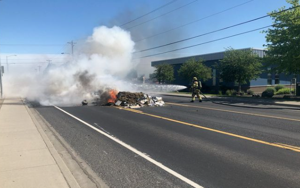(The Center Square) – Army veteran Warren Walker plans to send letters to the Spokane mayor and council members asking that they do not give in to demands by activists to remove a statue memorializing the late Ensign John Monaghan.
“I would really like the Spokane City Council to acknowledge that John Monaghan was a war hero, and that he represents history and tradition,” Walker told The Center Square. “Removing his statute because of activist feelings is a mistake. We should be honest enough to acknowledge this.”
Researching Monaghan’s background and reading newspaper clippings from 1899 about the gallantry of his actions turned Walker into an advocate for preserving the statue, which had come under fire. He is trying to enlist area veteran organizations in his fight to honor a man who died in the service of his country.
“Ensign Monaghan died a hero – this statute stands for that and nothing more,” said Walker.
Monaghan fought with about 250 American, British and Samoan forces near the city of Apia on Upolu Island. They were ambushed by 800 rebel fighters. Monaghan refused to join the retreat because he would not leave a severely injured officer behind.
“I’m a retired military guy and I understand the honor of his actions, so I am going to fight for him,” said Walker.
Monaghan was 26 when he was killed on April 1, 1899. At that time, American forces were ensnared in a Samoan civil war between two rival chieftains.
The statue that pays tribute to Monaghan’s sacrifice was erected on Monroe Street and Riverside Avenue in downtown Spokane and dedicated in 1906.
“Today, activists want you to believe that Eastern Washington citizens, by dedicating this statue more than a century ago, were racists,” said Walker.
The plaque on the monument reads: “During the retreat of the allied forces from the deadly fire and overwhelming number of the savage foe, he alone stood the fearful onslaught and sacrificed his life defending a wounded comrade Lieutenant Philip V. Lansdale United States Navy.”
Many Gonzaga students and community members of Samoan and Pacific Islander heritage in and around Spokane now want the statue brought down. They say it symbolizes racism, citing as an example the plaque’s reference to Samoans as the “savage foe.”
People who want the statue pulled down are now gathering signatures online to present to the city council with that demand.
“This monument – like the war it memorializes – is unjust,” states the petition. “The monument represents an injustice in that it attempts to honor Monaghan using a distorted and false depiction of both the war and an entire people.”
Walker said historical accounts of the battle that ended Monaghan’s life recount savage acts, which he believes is behind the reference on the plaque.
He cites a report from the Samoa Weekly on April 8, 1899, that addresses the mutilation of corpses and other atrocities. The article reported the heads of Monaghan and two other slain officers were cut off after they fell, and the ears of two British and three American sailors removed.
The three heads were later returned by a priest for the funerals of Monaghan and the other two officers, according to historical records.
Walker said a Samoan rebel is also reported to have cut off one ear of a wounded English sailor, Robert Hunt, who was still alive, but managed to escape.
“Cutting off heads and ears for trophies meets the definition of a savage act,” he said.
Opponents of the statue accuse Monaghan of participating in the shelling of villages that killed innocent Samoans. Walker said Monaghan might have been aboard the USS Philadelphia that reportedly shelled rebel villages, but he was not in charge of the vessel. He said Monaghan should not be held accountable for decisions made by commanders that were beyond his control.
Walker said records show that the land expedition with Monaghan did burn two rebel villages, but he added that both were abandoned when destroyed. He also called the letter written by Mrs. Fanny Stevenson, wife of RL Stevenson, who supposedly witnessed a U.S. bombardment that resulted in innocent deaths, suspect.
Fanny was a personal friend of the rebel chief whose forces killed Monaghan and she left Samoa in 1898, so was not in the area to witness the battle, he said.
“Activists are relying on our ignorance of history to make this statute represent their politics – and not what happened,” said Walker.
The actual history of the Samoan conflict is quite tangled, involving both Samoan dynastic politics and colonialism by French, British, and German nations. Repeated attempts by the United States to guarantee a self-governing Samoa were undermined by Samoan claims and counterclaims of leadership, and the brutal warfare waged by contending parties.
The thing that finally ended a truce was the conflict that claimed Monaghan’s life. When the April 1, 1899, ambush began, a retreat of those defending King Tanumafili I’s claim to the throne was sounded due to the overwhelming number of rebel fighters surrounding them.
Monaghan stayed behind was shot in the back and killed. His remains were brought home by the Philadelphia and he was buried in Spokane. Two Navy warships were later named after him.
Within the year, America Samoa, including several of the original Samoan islands and two atolls, became a U.S. territory by deed of cession. The office of king was abolished and Samoan autonomy officially ended.



